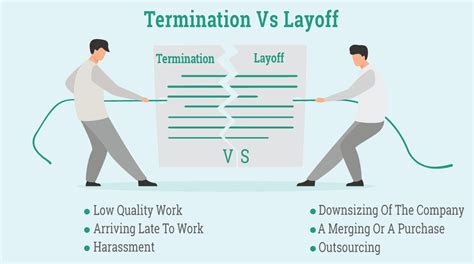Termination Vs. Layoff: Unpacking The Differences

When it comes to employment, many people are often confused about the difference between termination and layoff. Both terms refer to the ending of a job, but they are not interchangeable. Understanding the differences between the two can help you protect your rights as an employee and make informed decisions about your career. In this post, we’ll unpack the differences between termination and layoff to help you understand what they mean and what to expect.
What is Termination?
Termination is the ending of an employment relationship by the employer. It can be voluntary, such as when an employee resigns, or involuntary, such as when an employer fires an employee. Termination can occur for a variety of reasons, including poor performance, misconduct, or a change in business needs.
Types of Termination
There are various types of termination, including:
- Voluntary termination: When an employee decides to leave their job for personal or professional reasons.
- Involuntary termination: When an employer decides to end an employment relationship with an employee.
- Termination for cause: When an employee is terminated due to poor performance or misconduct.
- Termination without cause: When an employee is terminated due to reasons beyond their control, such as a change in business needs.
- Constructive dismissal: When an employer makes working conditions so intolerable that an employee is forced to resign.
What is Layoff?
Layoff is the temporary or permanent termination of employment by the employer due to a lack of work or a business slowdown. It is usually not the employee’s fault and is not related to their performance or conduct. Layoffs can also occur due to a company’s restructuring or downsizing.
Types of Layoff
There are two types of layoffs:
- Temporary layoff: When an employer temporarily lays off an employee due to a lack of work or a business slowdown. The employee is expected to return to work when the situation improves.
- Permanent layoff: When an employer permanently lays off an employee due to a lack of work or a business slowdown. The employee is not expected to return to work.
Differences between Termination and Layoff
The main differences between termination and layoff are:
| Termination | Layoff |
|---|---|
| Involuntary | Can be either involuntary or voluntary |
| Permanent | Can be either temporary or permanent |
| Employee’s fault | Not employee’s fault |
| Related to performance or conduct | Not related to performance or conduct |
| May be accompanied by severance pay or benefits | May be accompanied by recall rights or rehiring |
What to Do if You’re Terminated or Laid Off
If you’re terminated or laid off, there are a few things you can do to protect your rights:
- Review your employment contract, if you have one, to understand your rights and obligations.
- Ask your employer for a written explanation of why you are being terminated or laid off.
- Ask your employer about any severance pay or benefits you may be entitled to.
- Consider consulting with an employment lawyer to understand your legal options.
- Update your resume and start looking for a new job.
FAQs
Q: Can I be terminated or laid off without cause?
A: Yes, in most cases, an employer can terminate or lay off an employee without cause as long as they provide notice or pay in lieu of notice as required by law. However, there are some exceptions, such as when an employee is terminated due to discrimination, retaliation, or a breach of their employment contract.
Q: Can I be terminated or laid off while on maternity leave?
A: No, an employer cannot terminate or lay off an employee while they are on pregnancy or parental leave. Doing so would be considered discrimination and a violation of the employee’s rights under the law.
Q: Can I file for unemployment if I’m terminated or laid off?
A: Yes, in most cases, you can file for unemployment benefits if you’re terminated or laid off. However, there are certain eligibility requirements that you must meet, such as having worked a certain number of hours in the past year and being actively seeking new employment.
Conclusion
Termination and layoff are two different types of job endings that can have different implications for employees. Understanding the differences between the two can help you protect your rights and make informed decisions about your career. If you’re terminated or laid off, it’s important to take steps to protect yourself and your future job prospects.
